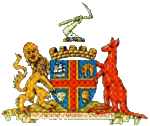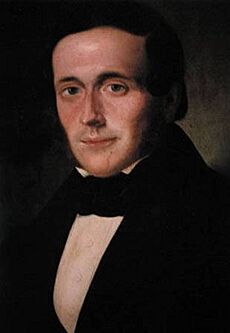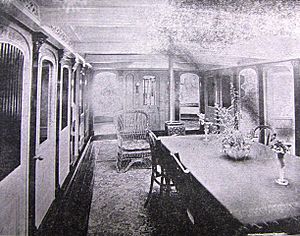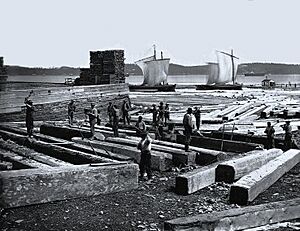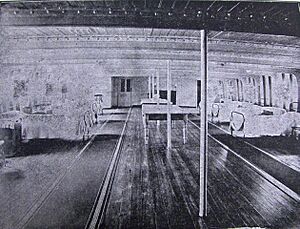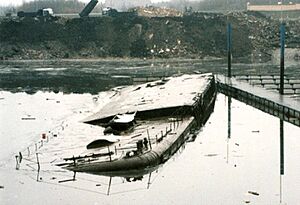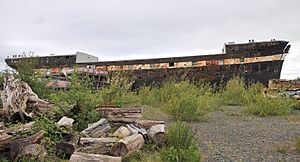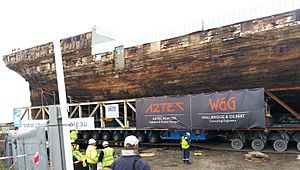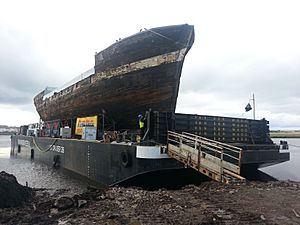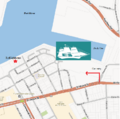City of Adelaide (1864) facts for kids

City of Adelaide. Hand-coloured lithograph by Thomas Dutton, 1864.
|
|
Quick facts for kids History |
|
|---|---|
| Name |
|
| Owner |
|
| Operator | |
| Port of registry |
|
| Route | London — Plymouth — Adelaide — Port Augusta — London (typical 1864–1887) |
| Builder | Pile, Hay & Co |
| Launched | 7 May 1864 |
| Commissioned | 1923 |
| Decommissioned | 1948 |
| Maiden voyage | 6 August 1864 |
| Out of service | 1893–1922; since 1948 |
| Stricken | Removed from register 7 February 1895 |
| Homeport | |
| Identification | |
| Nickname(s) | The City |
| Status | Awaiting restoration at Port Adelaide, South Australia |
| Badge | |
| General characteristics | |
| Type |
|
| Tonnage | 791 NRT |
| Length |
|
| Beam | 33.3 ft (10.15 m) |
| Depth | 18.8 ft (5.73 m) |
| Sail plan |
|
The City of Adelaide is a famous clipper ship built in Sunderland, England. It was launched on May 7, 1864. This amazing ship was designed to carry people and goods between Britain and Australia.
From 1864 to 1887, the City of Adelaide made 23 trips between London, Plymouth, and Adelaide, South Australia. It played a huge part in helping people move to Australia. On its way back, it carried passengers, wool, and copper from Adelaide to London.
After 1887, the ship had many different jobs. It carried coal around Britain and timber across the Atlantic Ocean. In 1893, it became a floating hospital in Southampton. Later, in 1923, the Royal Navy bought it and renamed it HMS Carrick to avoid confusion with another ship. It served as a training ship in Scotland.
In 1948, the ship was given to the Royal Naval Volunteer Reserve Club in Glasgow. It stayed on the River Clyde until 1989. After facing damage and threats of being taken apart, a big effort began to save it. In 2001, its name was changed back to City of Adelaide. In 2010, the Scottish Government decided the ship should move to Adelaide, Australia, to become a museum. It arrived in Port Adelaide on February 3, 2014, and is now being restored.
Contents
Why City of Adelaide is Special
The City of Adelaide is very important because it is the oldest surviving clipper ship in the world. There are only two clipper ships left, the other being the Cutty Sark.
This ship is also one of only three ocean-going ships built using a special method called "composite construction". This means it had a strong iron frame with wooden planks on the outside.
It is also one of the few surviving sailing ships that carried people who were moving from the British Isles to new countries. It was built especially for carrying passengers.
The City of Adelaide is also the last ship left from the huge timber trade between North America and the United Kingdom. This trade was very important for bringing immigrants to North America.
Because it was built before special rules for composite ships were made, its design is unique. It shows how shipbuilding technology was developing at the time. Experts say it was "over-engineered," meaning it was built extra strong, which helped it survive for so long.
How the Ship was Built
The City of Adelaide was designed to carry both people and cargo. It had cabins for first-class and second-class passengers. When needed, its cargo area could be set up for many more passengers, called "steerage" class.
This ship is a composite ship. This means it has a strong frame made of iron, but its outer skin is made of timber planks. This building method gave the ship the strength of an iron ship and the good insulation of a wooden one. Unlike iron ships, composite ships could have copper on their bottoms. This copper stopped sea creatures from growing on the hull, which made the ship faster.
Composite ships were built for a short time, mostly between 1860 and 1880. The City of Adelaide was built in 1864. Because it was an early example of this technology, it was built extra strong. This extra strength likely helped it survive, even after it got stuck on a beach in Australia in 1874.
Ship's Journey Through Time
Building the Ship
Captain David Bruce had a lot of experience sailing to Adelaide. He ordered the City of Adelaide to be built specifically for this route. The ship was built by William Pile, Hay and Company in Sunderland and launched in 1864. Captain Bruce owned a quarter of the ship.
The company Devitt and Moore managed the ship in London. Other owners included Harrold Brothers, who were agents in Adelaide, and Henry Martin, who owned copper mines in Australia.
Trips to South Australia (1864–1887)
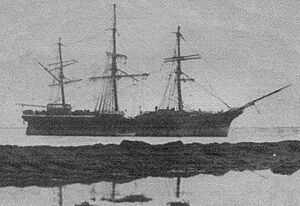
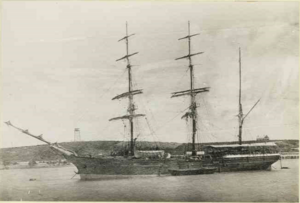
For 23 years, the ship sailed back and forth to South Australia. It helped the colony grow by bringing many new people. It's thought that a quarter of a million South Australians today can trace their family history back to passengers on this ship.
The City of Adelaide was one of the fastest ships on the London-Adelaide route. It once completed the journey in just 65 days!
In August 1874, the ship got stuck on Kirkcaldy Beach in South Australia. There were over 320 people on board. Sadly, some people had gotten sick during the trip. Strong storms caused the ship to run aground. Luckily, the passengers were safely taken off by tugboats, and the ship was refloated a few days later with almost no damage.
By the 1880s, the ship also visited Port Augusta, South Australia. There, it loaded copper from mines and wool from sheep farms to take back to London. In 1881, the ship's sails were changed, making it a barque.
Famous Passengers
Many interesting people traveled on the City of Adelaide, including:
- Sir Frederick Aloysius Weld: A former Premier of New Zealand and governor of other places.
- Cyril Maude: A famous English actor.
- Alfred Sandover: A generous donor in Australia.
- Matilda Methuen: The wife of a well-known Australian businessman.
- Frances Goyder: The wife of a famous surveyor in South Australia.
- Frederick Bullock: A future mayor of Adelaide. He kept a diary of his trip as a 15-year-old.
Carrying Coal (1887–1888)
In 1887, the City of Adelaide was sold to a coal merchant. It then carried coal from the River Tyne to Dover in England.
Carrying Timber (1888–1893)
From 1888, the ship was used to carry timber across the North Atlantic Ocean. This was a huge business at the time. Britain needed timber, especially for ship masts, and got a lot of it from North America.
Many ships carried timber from North America to Britain. On their return trips, they often carried people who were moving to new countries. This helped many refugees from Europe find new homes in North America.
The City of Adelaide sailed from Belfast to many ports in British North America, often to Miramichi, New Brunswick. It is the last surviving ship from this important timber trade.
Hospital Ship (1893–1922)
In 1893, the City of Adelaide stopped sailing and was bought by Southampton Corporation. It became a floating hospital to help people with infectious diseases. A new hospital in Southampton was later named the Adelaide Health Centre in its honor.
In 1923, the Royal Navy bought the ship. It was taken to Irvine, Scotland, and turned into a training ship. It was renamed HMS Carrick to avoid confusion with another ship called HMAS Adelaide. It served as a drill ship for naval volunteers.
Clubhouse in Glasgow (1948–1990)
After World War II, the ship was going to be scrapped. But thanks to some important people, it was saved and given to the R.N.V.R. Club (Scotland). It was towed to Glasgow and became the club's headquarters. This move was even called 'Operation Ararat'. The ship stayed there until 1989 when it was damaged by flooding.
Becoming a Museum Ship (1990–Present)
In 1989, the ship was damaged and almost lost. To protect it, the Glasgow District Council had it listed as a Category A historic building. A new group, the Clyde Ship Trust, bought the ship for £1 in 1990. It was moved to Princes Dock.
However, in 1991, the ship sank at its moorings. The Clyde Ship Trust couldn't afford to save it.
In 1992, the Scottish Maritime Museum rescued the ship and moved it to Irvine, North Ayrshire. They planned to preserve and restore it. Work continued until 1999, but then funding stopped. The museum faced pressure to remove the ship.
In 2013, ownership of the ship was transferred to Clipper Ship City of Adelaide Ltd. (CSCOAL).
Saving and Moving the Ship to Australia
Efforts to Save the Ship
After funding issues, the Scottish Maritime Museum considered taking the ship apart. Many people and groups, especially from Sunderland and South Australia, strongly objected.
In 2001, The Duke of Edinburgh held a meeting to discuss the ship's future. It was decided that the City of Adelaide was very important, but Scotland didn't have enough money to save it. The conference agreed that the ship should be known as City of Adelaide again.
A businessman named Mike Edwards later donated money for studies on restoring the ship. These studies showed it would be too expensive to make it sail again. It was decided it should be a static exhibit.
In 2006, the Scottish Maritime Museum again asked for permission to take the ship apart. This led to more protests from groups in Sunderland and Australia.
Rescue Plans
The South Australian group, Save the City of Adelaide 1864 Action Group, restarted its efforts. They argued that saving the City of Adelaide was even more important after a fire damaged the Cutty Sark.
Another group from Sunderland, SCARF, also wanted to save the ship and keep it in the UK.
The South Australian group became Clipper Ship "City of Adelaide" Ltd (CSCOAL). Their plan was to move the ship to Port Adelaide in South Australia. They launched online petitions and sent a letter signed by many important Australians to the British Prime Minister, asking to save the ship.
In 2009, the Scottish Maritime Museum asked for bids to either take the ship apart or remove it. CSCOAL submitted a bid to move the whole ship.
Decision to Move to Australia
In March 2010, the Scottish Government looked at different options for the ship. After careful review, on August 28, 2010, it was announced that the City of Adelaide would not be taken apart. CSCOAL's plan to move the ship to Australia was chosen as the best option. The cost to move it was estimated at about A$5 million.
Getting Ready for the Big Trip
Before the move, detailed surveys of the Irvine River were done because it had become very shallow. A special 3D laser scan of the ship was also made to help design the cradle that would carry it.
Companies in South Australia built a huge, 100-tonne steel cradle for the ship. This cradle arrived in Scotland in 2012.
There were some delays, including protests from the Sunderland group and negotiations for access to the slipway. During this time, the ship's timber rudder was sent to Australia first to test customs procedures.
In March 2013, the access issues were solved. Workers then put the special cradle together under the ship.
The actual journey began in September 2013. The City of Adelaide, on its cradle, was moved onto a barge and towed to Chatham, Kent. On September 20, 2013, it left the Irvine River.
A few days before a renaming ceremony, the Australian Government approved a grant of A$850,000 to cover the transport costs. On October 18, the Duke of Edinburgh officially renamed the ship City of Adelaide again.
On October 24, the ship arrived in Dordrecht, Netherlands, for special treatment to meet Australian quarantine rules. After this, on November 22, 2013, the clipper was lifted onto a large cargo ship, MV Palanpur, for its long journey to Australia.
The Final Voyage
One hundred and forty-nine years after its first trip to Adelaide, the City of Adelaide began its last voyage. It left Rotterdam, Netherlands, on November 26, 2013. The cargo ship carrying it crossed the Atlantic, stopped in Norfolk, Virginia, and then continued south.
On January 5, 2014, it stopped for fuel in Cape Town, South Africa, a port the City of Adelaide had visited many times before. After another stop in Port Hedland, Western Australia, the ship finally arrived at Outer Harbor in Port Adelaide on February 3, 2014.
New Home in Port Adelaide
After arriving, the City of Adelaide was carefully moved from the cargo ship onto an 800-tonne barge called Bradley. On February 6, it was moved upstream to Dock 1 in Port Adelaide's inner harbor. It stayed there for a while as a final location was prepared.
A big celebration for the ship's 150th anniversary was held on May 17, 2014. Schools and visitors now regularly come to see the ship and take tours inside.
In April 2017, the South Australian Government announced that Dock 2 would become the home for all of Port Adelaide's historic ships. On November 29, 2019, the City of Adelaide was towed to its permanent home in Dock 2.
Permanent Home
The City of Adelaide stayed on the Bradley barge in Dock 2 while plans were made to move it onto the land. The Clipper Ship City of Adelaide Ltd. (CSCOAL) has a long-term lease for the land. They plan to create a seaport village with the City of Adelaide as its main attraction.
In June 2023, the ship was lifted 1.5 meters on the barge. In June 2024, special transporters moved the ship from the barge onto its permanent spot at Dock 2. It now sits in a shallow pit, ready for its future as a museum.
Images for kids
See also
- List of museum ships


